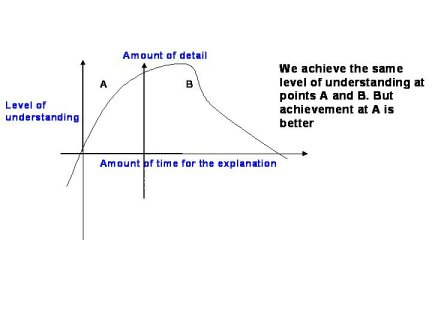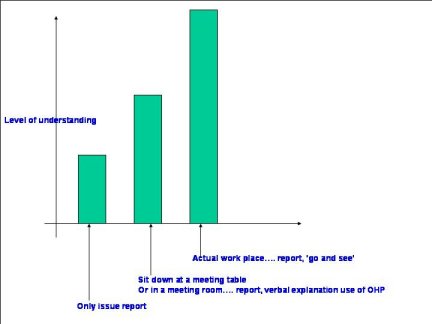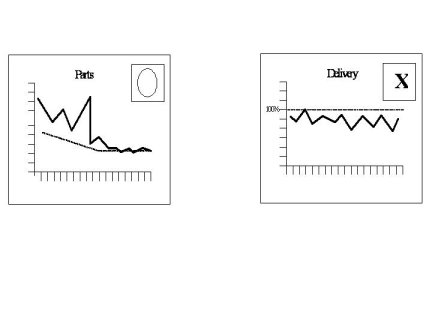A3 Reports
"How to write good A3 reports"
1. Preface - A3 Reports
A report is one of the most important communications media. Information has to be communicated accurately (quality), cost effectively (cost), promptly (timing) and in the right amount (quantity). It should be noted that a report, whether it is good or bad, represents the level of the writer in the organisation that he belongs to.
Reporting is mainly divided into the following two purposes: one is for the correct functioning of the organisation and to progress with work objectives. The second is to help communication between managers and workers.
By receiving a report, a manager cannot only confirm that his message has not only been conveyed properly to the team but also perceive the opinions and progress level. If he sees a problem he can deal with it immediately. To make this happen then a report is essential.
In a new era and with the day to day pressures it may seem too much trouble to make a good report, but to get used to good and proper report writing will improve the individuals ability and establish good communications within the organisation.
What is a good A3 report?
2. A3 Reports categories, purposes and requirements
2.1 Schedules (annual plan, kaizen plan, new activity, equipment installation, etc)
Purpose;
To control progress of a particular event, indicating activities that need to be carried out in the future by the use of 5W and 1H.
Requirement
1. To have a clear target and policy
2. To include improvements over past experience
3. To have clear timing for progress status reports
2.2 Progress status report (as above)
Purpose
1. To reflect actions taken in the past, grasp the current status and prepare for the future.
2. To report current status to the manager or members concerned for a better understanding to stimulate suggestions, assistance and instruction.
Requirement
1. To reflect actions taken so far in line with the plan to grasp the current status for future benefits.
2. To reflect items already carried out, to clarify items to be taken in the future following 5W and 1H.
3. Future progress can be estimated against the target.
2.3 Activities review report
Purpose;
To review if progress was followed or targets have been achieved for future benefits. In other words, to keep good activities as a standard system and, to identify and improve activities that went wrong.
Requirement;
1. Results should be compared with policy and target, using clear evaluation results
2. Each individual item should be evaluated to indicate contribution level towards the target and the next plan should include sound improvement (Kaizen) suggestions (5W 1H).
2.4 Technical report (test results report, investigation results report etc)
Purpose;
To inform the relevant Departments of technical facts obtained through facts obtained through investigation, evaluation, measurement, testing etc for situations with unclear causes and problem levels, which require technical handling. (Including interim reports)
Requirements;
1. Results must be clear in order for the relevant Departments to decide what they need to do next.
2.5 Countermeasure request/Kaizen request (CCW etc.)
Purpose;
To promote countermeasures and to follow up on progress.
Requirement;
1. Current status, concerns, countermeasure requests (suggestions) expected effect, expected timings should be made clear.
2.6 Recurrence Prevention Report
Purpose;
1. To prevent same or similar problems from happening again.
2. To make improvements on weak areas of control and to strengthen the organisation.
Requirement;
1. Causes should be identified to the different categories of the 5M (Man, Material, Machine, Method, Environment)
2. Appropriate countermeasures and prevention actions should be taken in terms of quality, quantity, cost, timing and safety.
2.7 Meeting minutes/ Results
Purpose;
1. To clarify items decided in the meeting to avoid difference in understanding among the participants.
2. To inform the people who did not attend or relevant people of the decisions made.
Requirements;
1. Decisions made should be clearly described using 5W and 1H
2.8 Bulletins, Daily Report, Weekly Report and Monthly Report
Purpose;
To report on conditions up to a cut off time without delay to the correct people to prompt appropriate actions. Requirement;
1. Reports should be on time
2. To include past performance (trend) and the target.
3. To include current status, temporary countermeasures, requests, permanent countermeasures and team member concerns.
3. What is a good A3 Report?
If an A3 Report purposes and requirements are described (why, when, what, when, where and how) appropriately (simple, clear and nice and easy to look at) cost effective and timely, it can then be called a good report. In other words 5W and 1H and good sense of quality, quantity, coat and timing are very important to write a good report.
3.1 Why?
A3 Reports, which do not convey a clear message on why they have been written or what they are trying to tell, are rarely taken notice of. They are far from a good report. Every effort must be made to ensure that the report written fulfils the purpose for what is has been written for. The purpose should have been decided before making the report.
Examples of purposes:
1. To help understanding
2. To share ideas
3. To request countermeasures
4. To obtain guidance, assistance or suggestions
5. To obtain instructions or approval
6. To review and prepare for the future
7. To take the next step forward or to make a decision
8. To communicate
9. To persuade relevant people to act
10. Others
3.2 Whom
It is necessary to change the writing style according to the reader without changing the basic idea. Although it does not really matter for the writer what style of report he chooses as he already has a full understanding of what he is writing, for the readers it makes a considerable difference. Amazingly this simple logic is uncommon.
An A3 Report to a Managing Director and a report to other lower levels are different in their styles. Especially in meetings such as Senior Management level where company progress is updated to the Senior Management, important points should be logically summarised in the report to give as much information as they need to know so that they know what actions should be taken.
3.3 What
As in section 2
3.4 Time (in minutes or in seconds)
To be able to communicate necessary information to the readers in a short period of time. It is human nature to feel better to report as much as or believe more information produces a better understanding. But this is not the case, unnecessary or too much detailed information hinders understanding.

3.5 Where and how A3 Reports Reporting methods affect understanding!

4. Methods
4.1 Paper size and number of pages
A3 and A4 sizes are mostly recommended. The more pages that you have, the more difficult the report is to understand, which leads to waste!
4.2 Title
The title should give the indication of the contents in a clear and precise expression.
Reason;
1. Title helps to understand the contents
2. It can be judged by the title if the contents needs close examination by individual readers
3. Priority can be decided by the title
4.3 20:80 rule, Conclusion first
For a one-sheet report use the first 20% of the space for 80% of the contents and allocate the rest of the space for the details of the remaining content. This makes the report very easy to understand (fast and accurate). Reading the conclusion after the image of the contents is obtained by reading the title as described in 4.2. (You have effectively grabbed the reader’s attention). For reports of more than 2 pages, use the first page for 80% of the contents and the remaining pages for the rest of the contents. Try to avoid allocating the second or other pages to the conclusion or items of request. However, if the following items are described concisely with the appropriate heading on a one-sheet report then, conclusion does not necessarily have to be first.
1. Purpose, background, basic approach
2. Current status, facts performance
3. Main concerns, countermeasures
4. Future direction, opinion, prediction
4.4 Simple expression
An A3 Report, which makes it difficult for readers to understand using complex expressions should be avoided. A3 Reports are different from a novel or a letter and the least use of descriptive words the better (don’t use 10 words when 1 will do). Unless you consider efficiency the report you raise will not be read!
Simple A3 Reports
1. Simple/clear (possibly short) sentences
2. exclude unnecessary/ unimportant content
3. use charts/graphs/drawings in order to show the status of a project or problem, also shoe examples if necessary
4. use drawings as much as possible to avoid the readers misunderstanding
4.5 the important part come first
For example if you want to show 3 conclusions then show the most important one early in the report, unless it is required in a special order such as time.
The same principle should be applied to problems or schedules for future actions.
The reason for this is ‘efficiency’. Just imagine if the most important conclusion came last!
4.6 clear requests
One of the most important functions of reports is to make people or an organisation do something. You should always communicate the exact request using 5W and 1H.
4.7 Initiators (Departments) Opinions
Unfortunately there are people that will attend and show reports, speak about themselves, and go! What have we learned? What do we need to do? You always need a policy for reporting. There needs to be a logical flow to your report, such as ‘this is what I think-this is what I want to do, please give me your opinion and cooperation’
4.8 Make the status clear
This is especially necessary for status reports such as daily/weekly/monthly reports. Within text it is difficult to understand the status at a glance. By the use of charts/ graphs/ symbols like O X comparing results/ status with the target, your status can be understood in a second.
4.9 Why and how good or bad?
You should show clearly why the status or result is ok, on plan or not, and how good or bad it is. This can help others to understand your report and to accelerate future actions.

4.10 Make countermeasure and progress clear
If the status/result is X, make the countermeasure clear according to 5W and 1H. It is your responsibility to improve X condition to O within a certain time limit.
4.11 Prediction of the future.
It is highly important in our job to be able to improve the condition of the future. It is easy to predict the future by means of analysing the past and present; this then allows us to understand what to do.
You must not only report the current status, but also past progress in order to achieve the purpose of the report. You can easily explain what to do in the future by means of reviewing the present.
4.12 Priority
It is very useful to make clear the priority in your report to understand each individual item but also to grasp the overall picture. With this in mind it is appropriate to emphasise important points by underlining, bold type or the use of colour etc.
4.13 Use of drawings or charts
Charts and drawings are a universal means of communication. Even if you don’t understand another language you can tell what is happening by the use of pictures.
You often use mainly text on your report with pictures as a complement. You should aim to explain the contents with pictures and use text as a complement (a single word is preferable) to allow the readers to understand quickly and correctly.
4.14 Neat text and drawings
It is human nature that we prefer to look at nice objects (e.g. paintings, flowers, nice scenery etc) and that we do not like to look at untidy and unsightly ones. Such aesthetic elements as nice and tidy text and drawings are very important for a good report.
4.15 Size of text
We rarely see a report written in too large text, what we tend to see is text that is too small. This comes from the natural need to cram as much as we can into as small a space as possible, this needs to be corrected.
Too small text does not stimulate the brain it only strains the eyes!
4.16 Layout Same principle as 4.13
4.17 Distribution
a) The basic rule of distribution is to target a certain position in the company and not to a specific person (excluding Senior Management). You need to distribute copies to appropriate positions in organisations in the right quantity. Also in cases of reports to Senior Management you will need to adjust the report so as not to give too much detail as far as data is concerned unless specifically requested.
4.18 Cost effective
Make every effort so that readers can obtain the necessary information from your report in the minimum time. Also try to reduce the number of copies, size of paper etc.
4.19 Be Timely
Reports raised too late are worse than not reporting at all! You should raise reports with consideration for the time that it takes to make approvals and distribution.
4.20 Self Check
Some people tend to submit reports without a full check of the report to confirm that it is doing what it is intended to do. You should always-self check your report to ensure that the contents are understood easily (don’t forget that you probably have a better knowledge of the subject matter then the reader). Avoid the use of acronyms and slang.
Main checking points are:
a) Logical links between purpose of reported matter, and conclusion
b) Readers should be able to follow the story from ‘purpose/ reason for’ to ‘conclusion/ suggestion in the future.
4.21 WHY HANDWRITTEN A3 REPORTS?
WHEN A3 REPORTS ARE HANDWRITTEN
• They cannot be e-mailed so forces face to face Communication.
• You have to understand the detail before writing.
• Because it takes more time you only produce valuable reports.
• You have to get a result to warrant the time spent.
WHEN REPORTS ARE ELECTRONICALLY PRODUCED
• Not enough time is spent on understanding
• We do not communicate effectively
• It is too easy to make and e-mail a report
• It can be used to absolve Blame or Ownership
4.22 NEMAWASHI (LINING UP YOUR DUCKS)
PURPOSE
In order to obtain consensus of the report and to gain sign off, it is advisable to spend some time prior to submittal gaining buy in to both your objectives and to peoples understanding of the content.
Requirement
Take time to walk the report through each signatory, sit down and explain content, actions and any surprises. This will speed up both the signature process and enable all concerned to feel more at ease with any actions arising from the report, which will provide ownership for the actions.
Result
Fully signed off report with clear understanding and ownership of actions.
Appendix
Items to be included in reports
Depending upon the type of report, the items to be included and order if inclusion depends upon the type of report that you are writing. Raise a GOOD report by referring to the following list:
1. Summary
2. Conclusion
3. Background or motive
4. Preface
5. Purpose
6. Objective
7. Reason for reporting
8. Process
9. Special feature
10. Current status
11. Policy
12. Past review
13. Interpretation
14. Schedule
15. Focus points of activity
16. Important points
17. Process outline
18. Structure
19. Problem
20. Priority
21. Countermeasure responsibility
22. Target
23. Conditions
24. Plan
25. Cause and effect analysis
26. Future actions
27. Request
28. Timing
29. Evaluation/ test results
30. Effectiveness of countermeasure, expected effectiveness
31. New problem
32. Action and results
33. Cause investigation
34. Influence on others
35. Review
36. Initiators impression/ opinion
37. Recurrence prevention
38. Future plan, future action
39. Remaining problems/actions
Get your full training pack for A3 Reports and learn how to become an extremely effective A3 Reports writer here-


